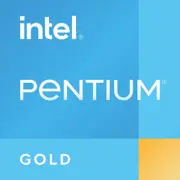Intel Pentium Gold G6605

Intel Pentium Gold G6605: A Budget Processor for Basic Tasks in 2025
Analysis of Capabilities, Compatibility, and Use Cases
1. Key Specifications: Architecture and Performance
The Intel Pentium Gold G6605 processor, released in 2020, remains a relevant budget solution due to its balance.
Architecture and Manufacturing Process
- Codename: Comet Lake (10th generation Intel).
- Manufacturing Process: 14 nm — an outdated technology but one that ensures stability.
- Cores and Threads: 2 cores, 4 threads (Hyper-Threading).
- Cache: 4 MB L3.
- Integrated Graphics: Intel UHD Graphics 630 (for basic tasks and light gaming).
Performance
- Geekbench 6: 935 (single-core), 1985 (multi-core).
- TDP: 58 W — low power consumption.
Key Features
- Support for Hyper-Threading to improve multitasking.
- Integrated graphics that do not require a separate GPU.
- Compatibility with DDR4 and PCIe 3.0.
2. Compatible Motherboards: Sockets and Chipsets
Socket: LGA 1200.
Chipsets:
- H410/B460/H470: Optimal choice for budget builds (price: $70–100).
- Z490: Overkill (supports overclocking, but G6605 is locked).
Selection Tips
- Ensure the motherboard supports 10th generation processors (often requires a BIOS update for new batches).
- Examples of 2025 models: ASRock B460M-HDV, Gigabyte H410M-H.
3. Supported Memory: DDR4 and Its Configurations
- Type: Only DDR4 (does not support DDR5).
- Frequency: Up to 2666 MHz (limitation of H410/B460 chipsets).
- Recommendations:
- 8 GB for office tasks.
- 16 GB for light video editing or multitasking.
- Cost: 8 GB DDR4-2666 — from $30, 16 GB — from $55 (new modules, 2025).
4. Power Supply Units: Power Calculation
- Basic Calculation: 58 W (processor TDP) + 50–100 W (other components).
- Scenarios:
- Without a graphics card: 300 W (e.g., be quiet! Pure Power 11 300W, $45).
- With a discrete GPU (e.g., GTX 1650): 450–500 W (EVGA 500 BR, $55).
- Tip: Choose units with 80+ Bronze certification for efficiency.
5. Pros and Cons of the Processor
Pros:
- Low price ($70–80 in 2025).
- Energy efficiency.
- Integrated graphics for basic tasks.
Cons:
- Only 2 cores — weak multi-threaded performance.
- Outdated 14 nm manufacturing process.
- No support for PCIe 4.0 and DDR5.
6. Use Cases
- Office and Study: Document work, browsing, Zoom.
- Multimedia: Streaming video (YouTube, Netflix), music.
- Light Gaming: CS:GO (720p, 40–50 fps), League of Legends (low settings).
- Not Suitable For: Video editing, 3D rendering, modern AAA games.
Real Example: A build for parents — quick application launches, movie viewing, without overspending.
7. Comparison with Competitors
- AMD Athlon 3000G (2 cores/4 threads, Vega 3):
- Cheaper ($60) but weaker in single-threaded tasks (Geekbench 6: ~800/1750).
- Intel Core i3-10100 (4 cores/8 threads):
- Price $100–120, 40% higher multi-threaded performance.
- Conclusion: The Pentium Gold G6605 is a middle ground between Athlon and i3.
8. Practical Assembly Tips
- Motherboard: ASRock B460M-HDV + Pentium Gold G6605.
- Memory: 8–16 GB DDR4-2666 (Crucial, Kingston).
- Storage: 256 GB SSD (WD Green, $35).
- Case: MicroATX with ventilation (Deepcool MATREXX 30, $40).
- Cooling: The stock cooler is sufficient.
Important: Check BIOS compatibility before purchasing the motherboard!
9. Final Conclusion: Who is the Pentium Gold G6605 For?
This processor is an ideal choice for:
- Budget PCs: Office, study, home theater (HTPC).
- Users not requiring high performance: Seniors, children.
- Temporary solutions: A "for now" build with potential for upgrades.
Why in 2025? Despite its age, the G6605 remains a cost-effective option for basic tasks due to its low price and energy efficiency. However, for gaming or serious work, it's better to consider more modern CPUs.
Summary: The Pentium Gold G6605 is a modest but reliable "workhorse" processor. It won't impress with its power, but it will handle everyday tasks without unnecessary expenses.
Basic
CPU Specifications
Memory Specifications
GPU Specifications
Miscellaneous
Benchmarks
Compared to Other CPU
Share in social media
Or Link To Us
<a href="https://cputronic.com/en/cpu/intel-pentium-gold-g6605" target="_blank">Intel Pentium Gold G6605</a>